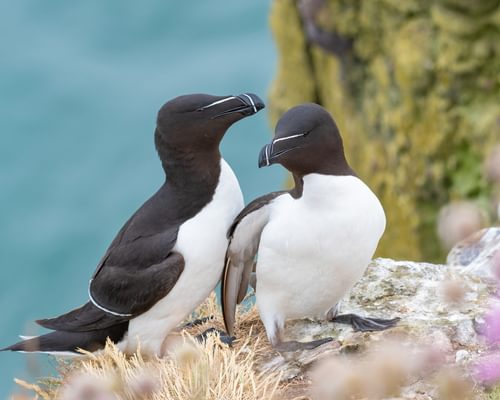Great Auk
Pinguinus impennis
Visual Identification
Appearance
The Great Auk was a large, flightless seabird with a black back and white underparts. It had a large, curved beak and small wings adapted for swimming. Adults stood about 75-85 cm tall and weighed 4-5 kg.
During the breeding season, adults developed a white patch over each eye and white grooves on their bills. Juveniles had a more mottled appearance with smaller bills.
Size
Length
75cm to 85cm
Wingspan
70cm to 75cm
Weight
4kg to 5kg
Colours
Males and females have similar plumage
Primary Colour
Black White
Beak Colour
Black
Leg Colour
Black
Habitat and Distribution
Habitats
Woodland
Garden
Wetland
Coastal
Urban
Farmland
Grassland
Desert
Tundra
Rainforest
Mountain
Savanna
Distribution
Great Auks inhabited rocky islands in the North Atlantic Ocean, ranging from Canada's east coast to Norway, with significant populations around Iceland and the British Isles. They required remote, rocky coasts for breeding.
During non-breeding seasons, they dispersed widely across the North Atlantic, venturing as far south as northern Spain and possibly the northeastern United States.
Elevation Range
Sea level
Climate zones
Subarctic, Temperate
Behaviour and Ecology
Bird Attributes
This feature is in beta. We'd love your feedback to improve it!
Share your thoughtsBird Attributes Explained
Our bird attributes system rates various aspects of a bird's capabilities on a scale of 0-100, based on data from field observations, scientific studies, and expert knowledge.
Attribute Categories:
- Agility: Manoeuvrability, speed, and grace in flight or movement.
- Strength: Physical power, often correlating with size and hunting abilities.
- Adaptability: Ability to thrive in various environments or changing conditions.
- Aggressiveness: Territorial behaviour and assertiveness, particularly during breeding seasons.
- Endurance: Stamina, often seen in migration patterns or foraging behaviours.
Understanding the Ratings:
- 0-20: Very Low
- 21-40: Low
- 41-60: Average
- 61-80: High
- 81-100: Very High
Remember, these attributes are relative to other bird species and don't necessarily indicate superiority.
Hover over the icon next to each attribute for more information.
Tap the icon next to each attribute for more information.
Agility
Reflects the bird's manoeuvrability, speed, and grace in flight or movement.
Whilst clumsy on land, the Great Auk was remarkably agile in water, using its wings to propel itself swiftly underwater to depths of up to 100 metres in pursuit of fish.
Strength
Indicates the bird's physical power, often correlating with size and hunting abilities.
As a large seabird weighing 4-5 kg with a robust build, the Great Auk possessed considerable strength, particularly in its swimming muscles and beak for catching and handling fish.
Adaptability
Represents the bird's ability to thrive in various environments or changing conditions.
The Great Auk's specialisation for marine life and inability to fly limited its adaptability, making it vulnerable to changes in its environment and human exploitation, ultimately leading to its extinction.
Aggressiveness
Measures the bird's territorial behaviour and assertiveness, particularly during breeding seasons.
Historical accounts suggest the Great Auk was not particularly aggressive. Its social nature in breeding colonies and lack of strong defensive behaviours against humans indicate a relatively docile disposition.
Endurance
Reflects the bird's stamina, often seen in migration patterns or foraging behaviours.
The Great Auk demonstrated impressive endurance in its ability to swim long distances, dive to considerable depths, and withstand the harsh conditions of its North Atlantic habitat.
Diet
Great Auks primarily fed on fish, particularly capelin and Atlantic menhaden. They were also known to consume crustaceans and marine worms. These birds could dive to depths of up to 100 meters to catch their prey.
Behaviour
Great Auks were excellent swimmers, using their wings to propel themselves underwater in pursuit of fish. On land, they moved awkwardly in an upright posture. They were known to be social birds, gathering in large colonies during the breeding season.
Vocalisation
Historical accounts suggest that Great Auks produced low croaking and gurgling sounds. On breeding grounds, they were reported to make a variety of grunts and low croaks, possibly used for communication within the colony and between mates.
Nesting & Breeding
Great Auks formed monogamous pairs and bred in dense colonies on remote, rocky islands. The breeding season typically began in May or June.
Females laid a single egg directly on a bare rock or in a shallow depression. The egg was pyriform (pear-shaped) and had intricate patterns of brown and black markings on a white or yellowish background.
Both parents shared incubation duties for about 6 weeks. After hatching, the chick was tended by both parents until it was ready to leave the nesting site, typically after 2-3 weeks.
Conservation and Status
Global Conservation Status
The Great Auk became extinct in the mid-19th century due to excessive hunting for its meat, eggs, and feathers.
Its demise is a stark reminder of human impact on wildlife and has influenced modern conservation efforts for seabirds and other vulnerable species.
Population Data
Global Population Estimate
0 (Extinct)
Global Population Trend
Trend data may be uncertain or fluctuating
Birdwatching Tips
As the Great Auk is extinct, it cannot be observed in the wild. However, birdwatchers can:
- Visit museums with Great Auk specimens
- Explore historical breeding sites in the North Atlantic
- Learn about conservation efforts for related species
- Study historical accounts and illustrations
Additional Information
Quick Facts
Predators
Adult Great Auks had few natural predators, but their eggs and chicks were vulnerable to gulls, skuas, and Arctic foxes.
Did You Know?
- The Great Auk was the only flightless bird native to the Northern Hemisphere in modern times.
- Its scientific name, Pinguinus impennis, reflects its penguin-like appearance, though it was not closely related to penguins.
- The last confirmed pair of Great Auks was killed in 1844 on the island of Eldey, off the coast of Iceland.
Similar Birds
References
- 1
website: BirdLife International. 2021. Pinguinus impennis. The IUCN Red List of Threatened Species 2021: e.T22694856A205919631.
View source
Share Your Feedback
We value your opinion! Let us know what you think about this bird page.
